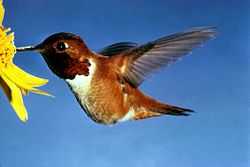Rufous Hummingbird
| Rufous Hummingbird | |
|---|---|
 | |
| Adult male | |
| Conservation status | |
| Scientific classification | |
| Kingdom: | Animalia |
| Phylum: | Chordata |
| Class: | Aves |
| Order: | Trochiliformes |
| Family: | Trochilidae |
| Genus: | Selasphorus |
| Species: | S. rufus |
| Binomial name | |
| Selasphorus rufus (Gmelin, 1788) | |
The Rufous Hummingbird (Selasphorus rufus) is a small hummingbird, about 8 cm long (3 inches) with a long, straight and very slender bill. The female is slightly larger than the male.
Description
The adult male, (shown in the photo), has a white breast, rufous face, upperparts, flanks and tail and an iridescent orange-red throat patch (gorget). Some males have some green on back and/or crown. The female has green upperparts with some white, some iridescent orange feathers in the center of the throat, and a dark tail with white tips and rufous base. Females and the rare green-backed males are extremely difficult to differentiate from Allen's Hummingbird. This is a typical-sized hummingbird, being a very small bird. It weighs 2–5 g (0.071–0.176 oz), measures 7–9 cm (2.8–3.5 in) long and spans 11 cm (4.3 in) across the wings.[2]
They feed on nectar from flowers using a long extendible tongue or catch insects on the wing. These birds require frequent feeding while active during the day and become torpid at night to conserve energy.
Because of their small size, they are vulnerable to insect-eating birds and animals.
Breeding
Their breeding habitat is open areas and forest edges in western North America from southern Alaska to California. This bird nests further north than any other hummingbird. The female builds a nest in a protected location in a shrub or conifer. The male aggressively defends feeding locations within his territory. The same male may mate with several females. The males can also become really aggressive toward the females.



Migration
They are migratory, many of them migrating through the Rocky Mountains and nearby lowlands in July and August to take advantage of the wildflower season there. They may stay in one spot for considerable time, in which case the migrants, like breeding birds, often aggressively take over and defend feeding locations. Most winter in wooded areas in the Mexico state of Guerrero, traveling over 2,000 miles by an overland route from its nearest summer home—a prodigious journey for a bird weighing only three or four grams.
This is the western hummingbird most likely to stray into eastern North America. In the United States, there has been an increasing trend for them to migrate southeast to winter in warmer climates like Florida or on the Gulf Coast, rather than in Mexico. (They do arrive at the Turks and Caicos Islands.) This trend is the result of increased survival with the provision of artificial feeders in gardens. In the past, individuals that migrated eastward toward Canada and the northern USA in error would usually die, but now they often survive as they seem to spend more time in the warm Gulf Coast and Florida. Provided sufficient food and shelter is available, they are surprisingly hardy, able to tolerate temperatures down to at least -20°C, so they can be seen in late fall in places like the Upper Midwest, Great Lakes, and upper New England. As winter comes birds in these areas normally head to the warmer Gulf coast and Florida.
Most hummingbirds that migrate east are juvenile birds and may occasionally be adult females but are very seldom adult males. Since juvenile or female are essentially indistinguishable from Allen's Hummingbirds unless they are examined in hand, many of the eastern vagrants are classified as "Rufous/Allen's Hummingbird". However, a majority are believed to be from the Rufous species.[3]
Research on hummingbird hovering
.jpg)
In 2005, a research team led by Dr. Douglas Warrick of Oregon State University used trained rufous hummingbirds in a study to determine the mechanics of hummingbird hovering. The study employed digital particle imaging velocimetry to capture the bird’s wing movements on film, which enabled the discovery that the hummingbird’s hovering is achieved due primarily to its wing’s downstroke (which accounts for 75% of its lift) rather than its upstroke (which makes up the additional 25% of the lift).[4][5]
References
- ↑ BirdLife International (2012). "Selasphorus rufus". IUCN Red List of Threatened Species. Version 2013.2. International Union for Conservation of Nature. Retrieved 26 November 2013.
- ↑
- ↑
- ↑ "Master fliers of the bird kingdom". BBC. 2005-06-27. Retrieved 2009-10-30.
- ↑ McCall, William (2005-06-24). "Study says hummingbirds fly more like birds than insects". Seattle Times/Associated Press. Retrieved 2009-10-30.
External links
| Wikimedia Commons has media related to Selasphorus rufus. |
| External identifiers for Selasphorus rufus | |
|---|---|
| Encyclopedia of Life | 916411 |
| ITIS | 178040 |
| Also found in: Wikispecies | |
- Rufous Hummingbird Species Account - Cornell Lab of Ornithology
- Rufous Hummingbird Selasphorus rufous - USGS Patuxent Bird Identification InfoCenter
- Photos of this and other Hummingbird Species - Hummingbird Society
- Quirks and Quarks show on rufous hummingbird time management abilities (mp3 file)
- Stamps (with RangeMap)
- Rufous Hummingbird videos on the Internet Bird Collection
